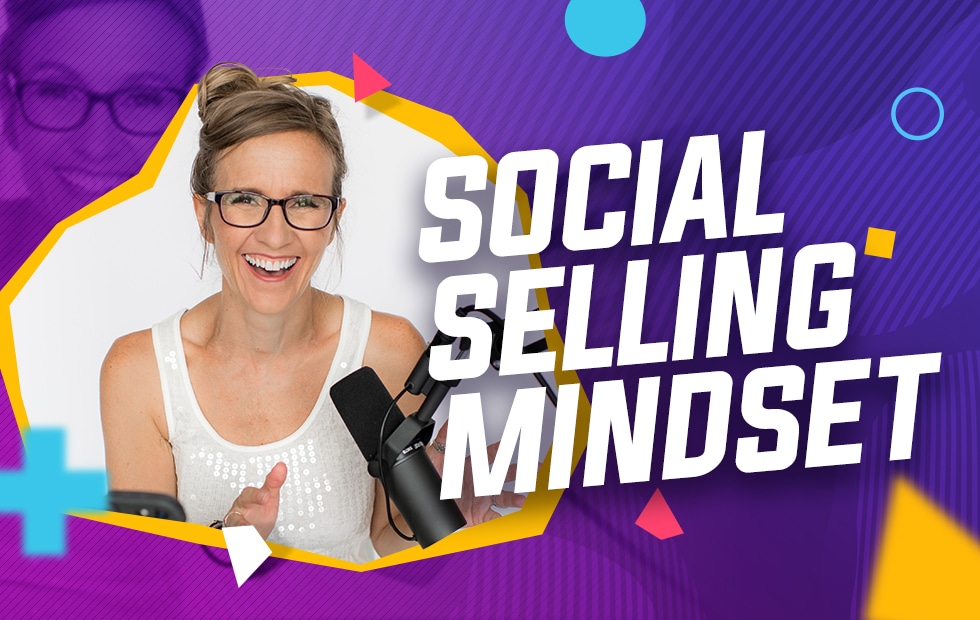
Social selling. Does reading that phrase alone make you cringe a little bit? What if I told you that social selling doesn’t have to be a struggle—that the key to having more fruitful interactions online is to change your social selling mindset?
As a coach, you’re probably already familiar with all types of social selling strategies. The thing is, there’s a big difference between knowing these strategies and actually being able to execute them.
Why? Well, we all know the feeling.
First, you log in to social media to reach out to a few followers, but you start to feel a little awkward. You begin to doubt whether your strategies are actually going to work, or you start to wonder whether people are going to judge you.
What happens? You feel a little awkward and uncomfortable doing it, so … you don’t do it!
Believe me, I get it.
But social selling doesn’t have to be painful. And rather than adding yet another social selling strategy to your arsenal, all you need to do is change your social selling mindset.
Today, I’m going to show you how to do this. Whether you’re approaching social selling the wrong way or whether you feel paralyzed by the fear of rejection, I’m here to help.
Let’s jump in!
Switching Up Your Social Selling Mindset
We’ve all seen those videos and blogs about social selling for coaches. You know, the ones that tell you to send out a template message whenever you see that someone has just followed you on social media.
This type of message will usually read something along the lines of …
Hey! Thank you for following me! Why don’t you tell me what your number one problem is?
Can I let you in on a little secret? This tactic almost never works! People can smell the desperation and insincerity from a mile away.
What’s more, desperate energy attracts desperate people. This means that the very few clients these messages do attract are the people who tend to take up a lot of our time, are often desperate for results, and simply aren’t in alignment with the type of people we want for our online coaching businesses.
Automation works for a ton of things. Why doesn’t it work in the case of social selling for coaches? Simply put, social selling is not an automated system.
At the end of the day, followers and subscribers are more than numbers. They’re real people. They don’t respond to generic, automated messages. They respond to authentic, personal connections—much like any person would in face-to-face interaction.
So, if you really want to make these types of genuine connections with people online, you’ve got to change your social selling mindset.
And guess what? That might mean putting your urge to sell on the backburner. It might require that you spend a little extra time cultivating personal relationships. It might mean investing in a tight-knit community of people.
Ask people questions. Check out their profiles. Comment on their posts. Reply to their stories. Show genuine interest in them.
And do all of these things without the end goal being a sale—without any of the “behind-the-scenes” scheming to get them to buy into your online coaching program.
Working Out Your Social Selling Muscles

So, we now know that to have an impact on social media, you’ve got to view people online as real human beings rather than mere numbers and figures. You’ve got to strive for authentic connections rather than desperate attempts at a quick sale.
And yet, you might still feel a little uncomfortable with the thought of being open and personable with strangers online. Starting a real conversation requires you to be a whole lot more vulnerable than copying and pasting an automated message requires.
But get this—interacting with people online is a lot like working out. In my Content That Converts workshop, I call this the “vulnerability flex.” Yes, being vulnerable is difficult at first—without a doubt. But the more frequently you work out these muscles, the more comfortable these types of social situations start to become.
Practice enough low-risk interactions with people and it will eventually become second nature. You’ll be able to connect with people left and right and even build your own little online community!
What would that look like?
Imagine that you made one online connection per week. Doesn’t sound all that difficult, does it? Well, that’s 52 connections over the course of a year, and that’s just the people you reached out to personally!
And check this out—those 52 people might have other friends who are interested in your coaching programs and also want to join your community. Before you know it, social selling is easy because you’re building your online influence on genuine relationships and community rather than template messages to cold prospects.
Of course, this is all much easier said than done for some. If you’re still struggling to drum up the courage to connect with someone online—perhaps out of fear that the person is going to react poorly—don’t worry. This next method is a game-changer!
4 Questions to Ask Yourself Before Social Selling
I recently finished reading this amazing book called Loving What Is. In the book, the author, Byron Katie, proposes that the reason why people feel uncomfortable interacting with someone is usually that they are projecting their own stories, assumptions, and feelings onto that person.
They won’t respond. They’re going to get upset. They probably think I’m trying to sell them something.
Of course, much of the time, these assumptions aren’t true at all. But that doesn’t stop them from feeling real to us. How do we overcome some of these beliefs and tear down the roadblocks that prevent us from interacting with people online and forming genuine connections?
Here are four key questions Byron recommends asking yourself whenever your own thoughts or feelings prevent you from interacting with someone!
Question #1: Is It True?
Those feelings or assumptions you’re having about a person or how they will respond to your message—are they true?
In many cases, you can squash any speculation right here. If you don’t think it’s true or doubt that it’s true, the reality is that you might be projecting those assumptions onto them. From this point, you can put that thought behind you and reach out to that person.
If you believe the answer might be yes, on the other hand, you can move on to question #2.
Question #2: Can I Prove That It’s True?
Even if you have a feeling that your assumption about how a person might respond is true, you have to ask yourself, can I absolutely know that it’s true?
And since the person you’re looking to interact with is a stranger, you’re probably working with a very limited amount of information. Perhaps you can see a name, a profile picture, and a few posts. Is this really enough evidence to prove that your assumptions about them are true?
Well, of course not!
Knowing that you can’t prove that your feelings about them are true, move on to question #3.
Question #3: How Do I Feel When I Have That Thought?
Now is the point when you should observe your own thoughts and feelings. Remember, your thoughts and feelings are the summations of a lifetime filled with various interactions and experiences.
They are there for a reason. Usually, it’s to protect you from things you may have experienced in the past.
And guess what? It’s OK to feel this way. Rather than banishing these thoughts and feelings, take some time to identify them, absorb them, and feel them.
When you’re ready, move on to question #4.
Question #4: How Would I Act if I Didn’t Feel This Way?
Finally, these thoughts and feelings you’ve taken time to process—what would change if they were gone? If you no longer felt this way, how would you act?
For most people, this would eliminate any hesitancy to reach out to that person—or any person at that—on social media. And that’s an incredibly liberating feeling!
In all likelihood, you’d be able to start conversations with ease, interact with more people, and build your very own online coaching community in no time.
Take it from me—I’ve applied these four questions to many of my own behavioural patterns and misgivings about others, and I can’t tell you how much it’s helped me work through the thoughts and feelings that have held me back from moving forward.
Transform Your Social Selling Mindset and Get Out of Your Comfort Zone!
Are you ready to get out there and start forming authentic connections with people on social media—whether it’s Facebook, Instagram, Snapchat, or another platform?
Practice makes perfect. The more you work your “vulnerability flex”, the easier these types of social selling interactions become over time.
And remember, if you ever find yourself struggling to get out of your comfort zone, take some time to process the feelings, thoughts, and assumptions you might be projecting!
Happy social selling!

